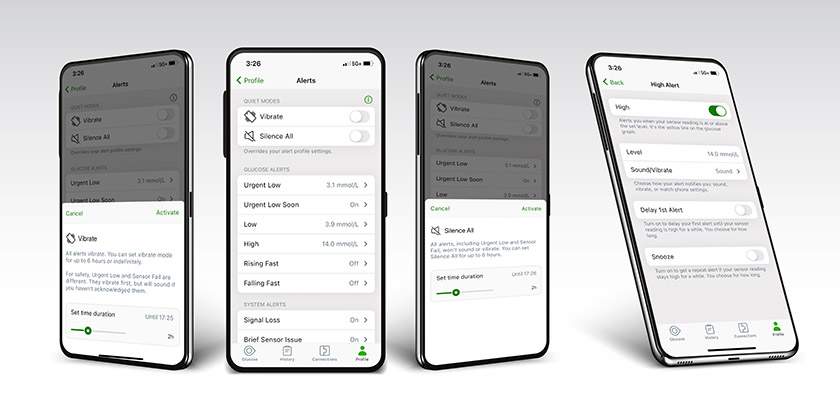Here’s How New Delay 1st Alert and Quiet Mode Features Improve the Dexcom G7 User Experience
The Dexcom G7 Continuous Glucose Monitoring (CGM) System has introduced a Delay 1st Alert function and two new quiet mode settings. Delay 1st Alert allows users to delay the first high alert for a set time, making future notifications more relevant. And the new quiet mode settings can help users avoid alert fatigue, improve diabetes management, and further personalize their CGM experience.

Delay 1st Alert Gives Users More Control Over Their Care
The Dexcom G7 high alert feature notifies users when glucose levels have surpassed their target range (generally defined by Diabetes Canada as 3.9–10.0 mmol/L). However, it can be expected that people living with diabetes will often experience glucose spikes, especially postprandial or after taking insulin. Excessive notifications may become frustrating and diminish the significance of future alerts, making users more likely to ignore them.
The new Delay 1st Alert setting in Dexcom G7 makes it possible for the user to delay the first high glucose alert for a preset time, ranging from 15 minutes up to 4 hours, long enough for any recent insulin dose to have taken effect.
For example, if the user sets their Delay 1st Alert to 20 minutes, their glucose must be at or above their high alert level for more than 20 minutes before they get the alert.
Delaying the first high alert ensures that when users do receive a notification, they’re more likely to take action to bring their glucose back into the target range. This new feature can aid in preventing episodes of reactive hypoglycemia while also helping the individual spend more time in range (TIR).
Within the Dexcom G7 app, Profile >Alerts shows all the alert settings and profiles that can be changed. Within the desired alert profile, tap on High to view and toggle the Delay 1st Alert feature on or off.
New Quiet Mode Settings Can Help Reduce Alert Fatigue
The Dexcom G7 CGM System has also introduced two new quiet mode settings for additional customization and alert relevance; Vibrate and Silence All.
The first setting is Quiet Mode (Vibrate):
- All Dexcom G7 alerts will vibrate but not sound.
- Can be set for up to 6 hours or indefinitely.
- Urgent Low and other technical alerts (for example, Sensor Failed) will still sound if they are not acknowledged.
The second setting is Quiet Mode (Silence All):
- All Dexcom G7 alerts will be silent—no sounds or vibrations.
- Can be set for up to 6 hours.
- Visual alerts will still be displayed on the user’s compatible display devices.
Users should check their display devices often when using the Quiet Mode settings to avoid missing a potential hypo- or hyperglycemic event.
Within the Dexcom G7 app, Profile >Alerts shows all the alert settings and profiles that can be changed. Tap on Show Quiet Modes to toggle Vibrate and Silent All modes on or off.
Discover Dexcom G7 Before Prescribing
Features like the Delay 1st Alert help individuals take control of their diabetes management while improving their quality of life. If you’d like to explore the Dexcom G7 CGM System further before prescribing, request a sample or speak to your local Dexcom representative.
1 Imran AS, et. al. Diabetes Canada 2018 Clinical Practice Guidelines for the Prevention and Management of Diabetes in Canada: Targets for Glycemic Control. Can J Diabetes. 2018:42(S42–S46). doi: 10.1016/j.jcjd.2017.10.030
2 Altuntaş Y. Postprandial Reactive Hypoglycemia. Sisli Etfal Hastan Tip Bul. 2019;53(3):215-220. Published 2019 Aug 28. doi:10.14744/SEMB.2019.59455
3 Dexcom G7 User Guide, 2023.
MAT-1128 V1.0
